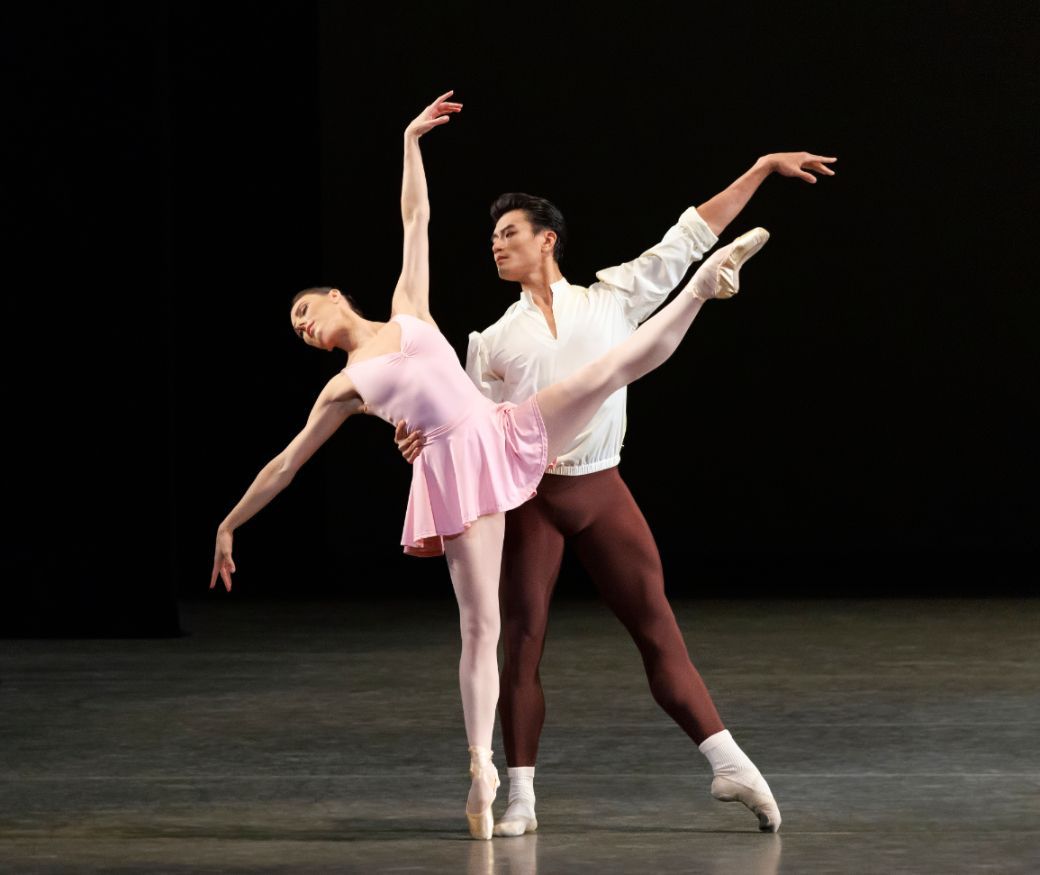The Goldberg Variations by Jerome Robbins opened starkly: a lonely pianist hemmed into a barely-lit corner of the apron, notes spilling mournfully out of the piano. Over 84 minutes a series of small miracles unfolded as the New York City Ballet dancers came and went in a quirky nonlinear account of Western dance history from the baroque to neoclassical, flirting with asymmetry, disorder and same-sex partnering. Canons and fugues abounded as they do in Bach’s string of sketches, likened by Víkingur Ólafsson to ‘an encyclopedia of how to think and dream on the piano’.

Dancers gradually donned or discarded the ruffles, flounces, doublets and knee breeches that allude to a bygone era in which dance reflected the ideals of noble etiquette and moral discipline, mirroring the order of the state, with courtiers orbiting the king, for whom stalwart pianist William Wolfram served as stand-in.
Robbins counterposed this world and the world he had indelibly drawn in earlier works from Afternoon of a Faun to West Side Story, N.Y. Opus: Export Jazz and Dances at a Gathering – that of modern youth, restless and rebellious, self-absorbed and contemplative, carefree and flirtatious – to transfixing effect. Insouciant hip bumps and cartwheels preceded courtly révérences. A pair of youths chased each other across the stage in lightly beaten jumps then lolled on the ground, stretched their hamstrings and scribbled idly on the ground, in a blithe canon. Three men spun their partners on their derrières then, grasping both hands, threaded their way decorously through the circle of their arms in a playful variant on a minuet handhold.
Six trios nestled companionably within each other’s arms then one by one the women were swept up and off into the wings in a variety of lifts that blossomed in slow motion. Their poetic ascent ushered in a new group in celestial blue practice dresses who barreled on like ocean waves.
On opening night, eight of the 14 soloists were making debuts. Standouts included Ashley Hod who danced with authority and abandon, streaking through the air in gigantic sideways leaps and whirling hops in attitude derrière – like Giselle being initiated into the Wilis but very much alive. And Emma Von Enck, who danced lightly yet sumptuously, windswept yet grounded.
Taylor Stanley wound and unwound Ashley Laracey in tricky slow revolutions, and made a circle with his arms through which she took a running dive. At one point he got her on her balance before she collapsed dramatically. Their machinations evoked both the operation of a complex piece of machinery and a relationship of trust and affection, lightened by her wonderfully ironic manner.
The glorious Isabella LaFreniere and steadfast Tyler Angle made a pas de deux of expansive sorrowful unfurlings. He slid and dragged her; she fell backwards over his shoulder and développéd one leg skyward; she took broken steps on pointe as if she were learning to walk, but learning to walk beautifully. In a momentary lull, they stood back to back; he stretched one leg behind him and bent his knee; she perched in the bend, fragile yet captivating. This relationship seemed like a lot of emotional work for him. When she walked out on him (still walking beautifully) he slumped over in despair, only to be revived moments later by Bach/Wolfram’s insistent nudging. With LaFreniere now a distant memory, he sprung into lively beats and floor-skimming turning jumps.
Against the austere splendor of The Goldberg Variations, everything was showy and over-the-top in George Balanchine’s four-part Tschaikovsky Suite No. 3. Megan Fairchild, in her parting season with the company, captained the troops with Anthony Huxley in the crisp and dazzling Theme and Variations. She went hell-for-leather through the flickering jumps, the whipping changes of direction and the giddy scribbling of helixes in the air with pointed feet. Unclear whether dancer or conductor was setting the furious pace but the effect was mostly brisk and efficient, with less time to luxuriate in the spiraling energy of angled body lines or the full drama of steep plunges in arabesque. The corps with their shimmering bourrées were on top form.
The timeless grandeur of Theme and Variations is unmatched by the three swoony prequels which Balanchine tacked on in 1970 after a gap of 23 years. Behind a scrim that produced a hazy, underwater effect, men in ruffled blouses pined after barelegged women draped in long layers of glittery diaphanous tulle, who flung their hair about beautifully, none more so than the willowy Miriam Miller who had a thing with Ryan Tomash but ultimately abandoned him. Emilie Gerrity stalked Preston Chamblee with a sinister smile. The ‘Scherzo’ was mainly a lot of tearing around, but Daniel Ulbricht dialed up the manège to stirring effect and among the ensemble Olivia Bell conveyed a sense of urgency while dashing from pillar to post.


